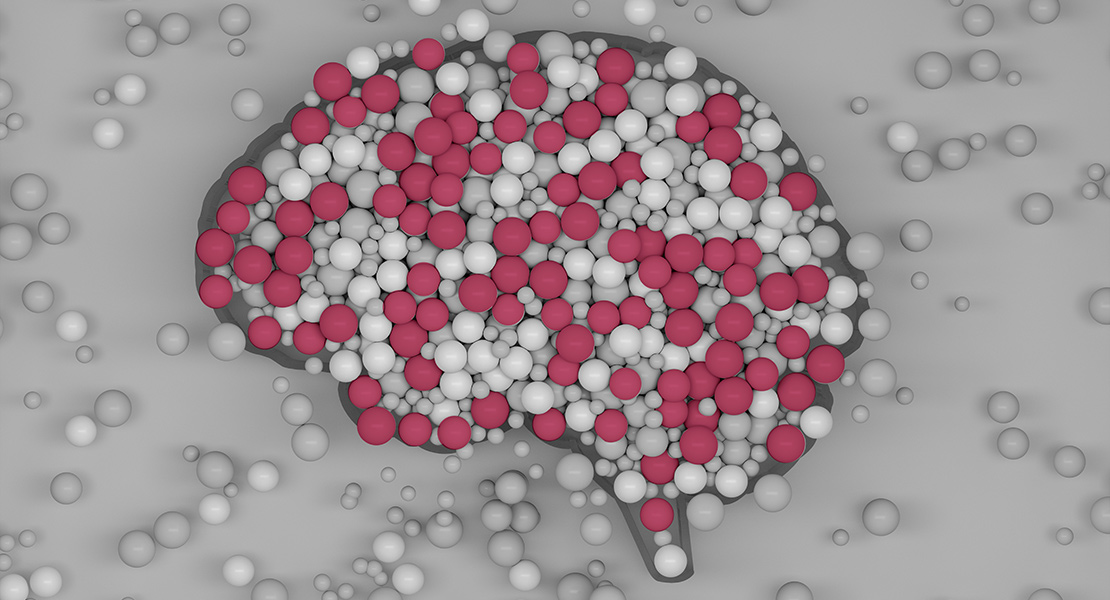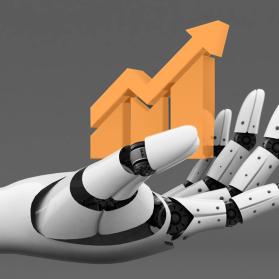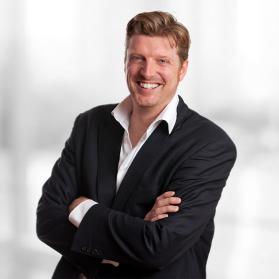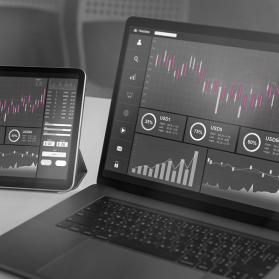In November 2017, Detecon's Digital Engineering Center (DEC) in Berlin was officially opened. What does the work look like four months after its founding? Which topics are in the foreground? We asked our Consultants Elena Fomenko and Fabian Wiktor - and discovered an exciting tension between Artificial Intelligence, ethical questions and the right mix between physical and digital.
Above all, the DEC strives to work on implementable solutions for the customer. What exactly does that mean, what can customers expect?
Fabian: The strategic focus of DEC covers two dimensions: for starters, we focus heavily on research and innovation topics in order to identify the next wave of game changing developments at an early stage.
We are constantly scanning the environments in order to build up knowledge and experience, which we then transfer into practice with our customers. The activities we conduct range from helping our customers to avoid a massive technology shock, to co-create new and disruptive ideas to reinvent their business, all the way to towards helping their organizations set up innovation units, labs or hubs.
On the other hand, the DEC has an active role implementing or demonstrating technical feasibility of solutions and ideas. This means that we do both the conceptual development and the process to transform ideas into actionable working constructs, be it in the form of interactive demos, hard- and software prototypes, proof of concepts (PoC), etc. We always say that, if you can think about it, we can probably build something to show you how it will look like or work like once it’s built.
Elena: One example of the first focus Fabian mentioned could be the Digital Engineering Center’s Analytical Intelligence team. To stay up to date and skilled, we internally apply and test new Artificial Intelligence (AI) technologies to learn about their strengths and weaknesses. The knowledge we gain is used constantly to help our customers successfully apply analytics and artificial intelligence technologies to achieve their goals. To maintain overview, we created an AI tool ‘orchestra’, which allows us to combine different techniques that we can use to build a well working algorithm, that solves our customers’ problems. This orchestra is the one we constantly update with the newly tested technologies.
As an example of a hands-on project, I could mention our cooperation with a big insurance company. Currently, we are helping them set up a data science team, as well as develop and implement different use cases. In particular the DEC AI team is responsible for improving of cross and upsell potentials through predicting purchase probabilities; and speed up damage processing by detecting the "dark processing potential" through analytics.
Fabian: At the Co-Innovation DEC we are the methodological connectors between all other DEC’s and the innovation consultants for our customers. That doesn’t only mean that we actively do analysis of trends and their respective impacts on the business of our customers, but also work in a co-creation approach to construct compelling customer journeys and user experiencesfrom research over ideation to application POC’s and prototypes, putting a broad spectrum of the most modern tools and agile methods into practice.
Moreover, with the knowledge and innovation network we’ve created, we’re creating effective innovation ecosystems with our customers, enabling them to build up an innovation culture from within their organization.
At the Detecon corporate event "BEYOND" in February everything suddenly turned on a mysterious suitcase. What's it all about?
Elena: The main purpose of the current customer project was the development of a solution to demonstrate the power of AI in improvement of end customer businesses. As a result we developed for our customer a self-build demonstration kit, which:
- show benefits of AI in real-life focus on common use case scenarios
- are easily recognizable, easily adaptable and easy to use/deploy for demonstration purposes and
- underpin the current importance and prove the future importance of digitalization (across industries).
With the prototype, our customer now can demonstrate the major advantages of adapting AI technology, in our case image recognition, for advanced quality control using an interactive example. A hardware demonstrator has a high power in attracting end customers and leads to a higher number of follow-up projects using this technology.
The major advantages for using state of the art image recognition technology for advanced quality control, which could be demonstrated through the prototype are the following:
- Use of automated image recognition system enables a quality check of products on an early stage.
- The solution is a fully automated, precise and highly scalable system for quality control at low costs on each step of the manufacturing process.
- High accuracy of the quality check is achieved by applying convolutional neural networks and very fast image processing speed per second.
- Advanced technologies enable training a system to identify a fault for a new production part in a day or even a few hours.
- Collect valuable data for the predictive quality management and to uncover major quality issues.
Fabian: A couple of words about the software and hardware as well as the development process behind the prototype:It is important to mention that the demonstration kit is conceptualized, designed, programmed and build internally in a joint effort of the Co-Innovation and Analytical Intelligence Centers. We’ve teamed up in our location here in Berlin and combined advanced analytics technology with 3D-modelling on the computer followed by skilled hands-on assembly on the workbench.
The result is a simulator of a production line, featuring a moving conveyor belt and engine, powered by a self-created algorithm that runs on a manually programmed chipset. The whole masterpiece was custom fitted into an aluminium suitcase with transparent cover panels.
While the Co-Innovation team designed and build the prototype, the AI team were responsible for programming the conveyor belt as well as for the development and training of the image recognition algorithm. The basis for the algorithm was a powerful TensorFlow library with the convolutional neural networks method at the core.
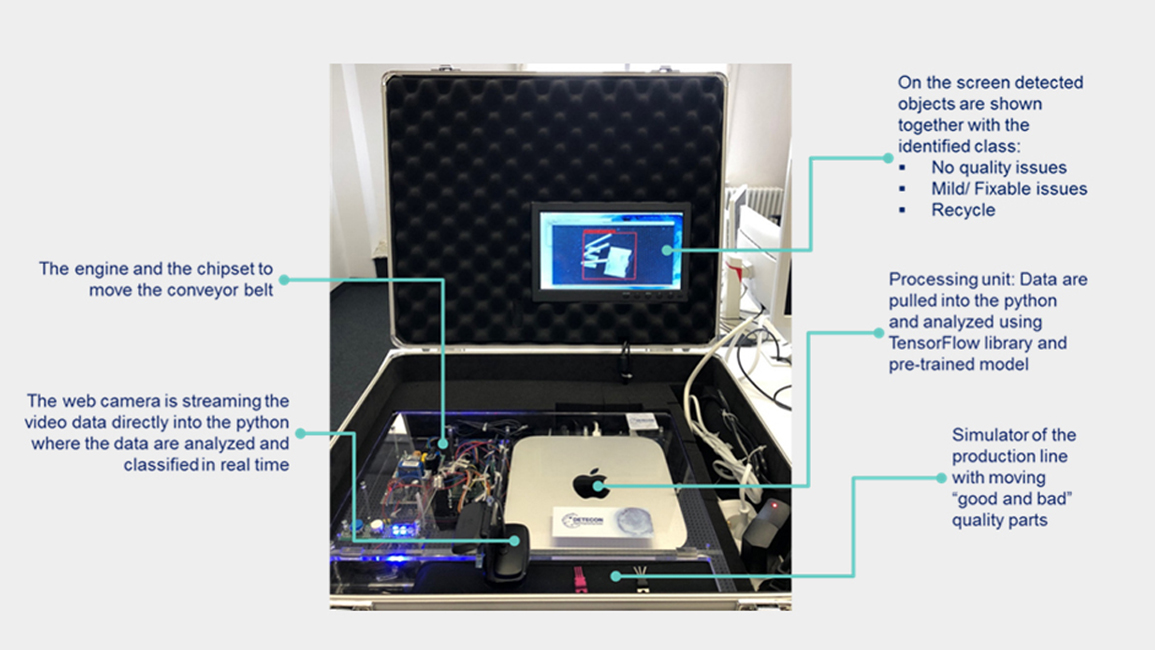
The first quarter of 2018 is over. What kind of hype do you see coming this year?
Elena: As a data scientist, I clearly see that Artificial Intelligence will have a huge impact on our future and 2018 will be the year when lots of things will happen in AI context. We see, for instance, more and more how the AI software stack differs from the traditional software.
The major examples here are:
- novel interface mechanisms (one will be voice, both as an input and as the output, second will be images, where embedded cameras will provide large-scale inputs to machine-learning systems);
- hardware designed specifically for AI (e. g. Google’s TPUs);
- novel AI frameworks (TensorFlow and its competitors) and
- Cloud-to-edge computing as a new framework to run AI applications.
Another trend is augmenting human capabilities with AI. Reinforcement learning, adversarial networks, one-shot learning, and unsupervised methods are technologies with very high potential there.
Additionally, AI will be the technology investment priority for large firms. In this context, the discussion on how AI will influence employment will move from uncovering the trend to how we can enable our employees to be fit using the technology (e.g. combine an investment in AI training and facilitating the entrepreneurship and innovation spirit).
Considering all the trends named above for sure AI ethical questions will be one of the major topics in 2018.
Fabian: There will definitely be a renaissance of the physical when it comes to brand experiences – partially due to users’ growing fear of “screen addiction”!
We are already seeing a strong need and desire of users to evolve from solely digital experiences towards interacting more with physical technology touchpoints. It doesn’t mean, that there will be less digital experiences, but we are already seeing how the digital and the physical are blending together more and more, putting well-designed tangible experiences in the foreground as the touchpoint and fuelling them with well thought-through digital experiences in a wide array of possible use cases from home appliances to even leisure activities.
So keeping a focus on the right mix between physical and digital when designing user experiences will make a big difference in 2018. In the DEC we’re covering this by incorporating hardware prototyping into our design process and into portfolio as one of the major differentiators.
As Lena already mentioned before ethics will play a big role in business in 2018. Due to a higher degree of transparency across many channels a general societal trend can be observed – polarization, caused by people’s expectations of companies taking position concerning societal, political and moral topics and owning up if they made mistakes.
Making a real difference in the world and looking at ethics as a key metric will soon be the key to successful business. When contributing to the development of Detecon as a company and also when designing new business models and products for our customers we are keeping this in mind and advise our clients accordingly.
One last thing to consider for 2018 will be that although design thinking has become a common practice for development and it seems that everyone who has taken one design thinking course can consider himself a designer – therefore blurring the lines between novices and experts. We need to point out, that design isn’t only a tool to solve problems, but even more it is the potential to differentiate clearly from competitors in the market.
Therefore, in order to ensure effective, sustainable and successful design within organizations, it needs to be embedded into an organizational environment that fosters holistic design approaches – combining design craft with processes, roles & structures as well as skills. Whereas methods can be learned quickly, the craft of design itself can’t. Combining this differentiating factor that actually creates compelling experiences with the data perspective will provide the future advantage for organizations.
In the DEC we chose to work according to this principle already today. Our cross-functional Data Thinking approach as well as the experts in the Co-Innovation DEC are the perfect examples of how Detecon pushes forward, surfing on the latest trends in technology and organizational development.
So with all that, it’s going to be a really exciting year 2018.

